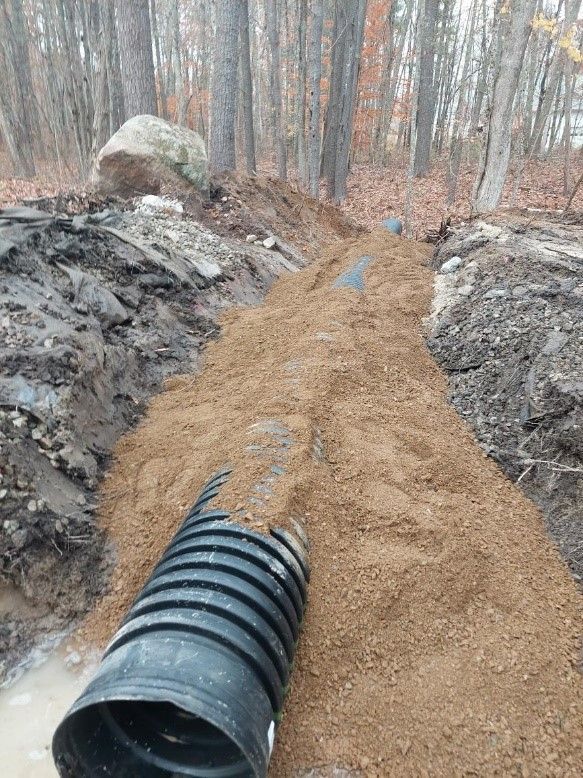Top Quality Road Construction for Long-Lasting Roads
Top Quality Road Construction for Long-Lasting Roads
Blog Article
Culvert Setup Made Easy: Step-by-Step Guide for Success
Installing culverts may look like an uncomplicated job, however making certain an effective result requires careful preparation and implementation. From choosing the suitable culvert size to integrating proper water drainage actions, each action in the setup process plays an essential role in the capability and durability of the culvert system. By complying with a methodical method and taking notice of key information, the setup can proceed efficiently, lessening potential concerns down the line. Remain tuned to uncover the essential actions and considerations that can make culvert setup a smooth and effective undertaking.
Choosing the Right Culvert Size
Picking the suitable culvert dimension is essential for making certain efficient water circulation and structural integrity in culvert setup projects - Pad Construction. The size of the culvert straight influences the flow capacity of water with the framework. A culvert that is too little can result in flooding and overflow, while one that is also large may cause decreased water speed, possibly causing sediment build-up and clogs
To figure out the best culvert dimension, factors such as the watershed location, peak circulation prices, and hydraulic performance requirement to be thoroughly thought about. Computations based upon these specifications help in choosing a dimension that can appropriately take care of the predicted water quantity while decreasing the threat of blockages and structural failing.
It is necessary to get in touch with engineering guidelines and criteria to make certain that the chosen culvert size meets the task requirements and local policies (Pad Construction). By picking the best culvert size, project managers can optimize water circulation, prevent potential concerns, and enhance the general effectiveness and long life of the culvert installment
Preparing the Setup Website
Effective culvert setup necessitates thorough preparation of the installation website to guarantee optimal architectural support and functionality. Prior to beginning the installation procedure, it is critical to remove the site of any kind of debris, plant life, or blockages that could hamper the culvert's placement.
Additionally, it is essential to consider aspects such as dirt composition, groundwater degrees, and environmental effects when preparing the setup site. Performing a comprehensive website analysis can help determine any kind of potential difficulties or threats that might affect the culvert's performance. By putting in the time to prepare the installment site properly, you can assist assure an effective culvert installment that fulfills structural needs and guarantees long-lasting capability.
Positioning the Culvert Correctly

The grade at which the culvert is positioned is essential for keeping an appropriate incline for water flow. A gradual incline assists prevent pooling and promotes efficient drain. In addition, the culvert should be oriented properly to make sure that the inlet and electrical outlet are in the appropriate areas. This orientation is crucial for the culvert to function properly in handling water circulation.
Backfilling and Compacting the Dirt
Appropriate backfilling and compaction of the dirt around the culvert is vital to ensure stability and stop prospective issues in the future. When the culvert is correctly positioned, the next critical step is to backfill the area around it with appropriate product. The backfill material must be without rocks, debris, and organic issue to avoid damages to the culvert. It is advised to use granular product such as sand or crushed rock for backfilling, as it offers excellent drainage and compaction residential properties.
After placing the backfill material, it is essential to portable it in layers of consistent density. Utilizing a compactor or a mechanical tamper, small the soil gently to stay clear of harming the culvert. Compaction aids in reducing the chances of settlement and guarantees consistent assistance around the culvert. It is essential to small the dirt evenly on all sides of the culvert to preserve its structural honesty.
Proper backfilling and compaction not only offer stability to the culvert but likewise help in stopping soil disintegration and maintaining the durability of the culvert system.
Ensuring Appropriate Drain Integration
Incorporating effective drain services plays a critical function in the total functionality and durability of culvert installations. Appropriate drain integration is necessary for managing water flow, protecting against erosion, and making sure the architectural integrity of the culvert system. To accomplish this, it is essential to design an extensive water drainage strategy that considers aspects such as the quantity of water anticipated, the topography of the area, and the type of soil existing.

Additionally, including attributes like erosion control steps, such as riprap or vegetation, can further boost the efficiency of the drainage system. By carefully intending and carrying out these drain solutions, culvert installments can work efficiently and hold up against the examination of time.
Conclusion
In conclusion, correct culvert installation is crucial for keeping effective drainage systems. By choosing the best culvert dimension, preparing the setup website, putting the culvert Tree removal correctly, backfilling and condensing the soil, and making certain appropriate drainage assimilation, success can be achieved. Adhering to these steps will certainly help make certain the longevity and performance of the culvert, ultimately adding to the overall success of the drain system.
Report this page